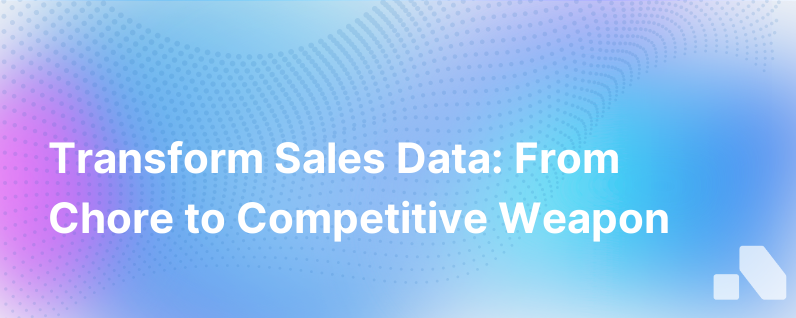
The copious amount of sales data generated and stored within organizations has both a blessing and a curse. On the one hand, it contains valuable insights that could revolutionize your sales process. On the other, it can represent a daunting task of analysis that many sales teams view as a low-value chore. Yet, when positioned properly, this sales data can be transformed into a high-potential strategic weapon. Let’s explore three proven strategies to make this transformation possible, ensuring that you and your team are utilizing sales data not just systematically, but strategically.
Strategy 1: Integrate and Automate Data Synthesis
The Challenge
The collection and synthesis of sales data can be incredibly time-consuming. Sales reps may have to log interactions across multiple platforms, pull reports from different analytics dashboards, and manually input data into CRM systems. This disjointed process is inefficient and error-prone, leading to a widespread perception of data management as a tiresome duty deterring sales teams from their primary goal of closing deals.
The Transformation
Automation is the first step in elevating sales data from a task to a tactical tool. By integrating data sources and employing sales analytics platforms, you can streamline the data collection process and ensure that actionable insights are derived without exhausting manual labor. Automation software can capture interactions across all customer touchpoints, aggregate the data into a single repository, and use advanced analytics to highlight key performance indicators and trends. This ensures that the process is both time-efficient and reliable, allowing sales teams to interpret the results and adapt their strategies with accuracy, freeing up their time to focus on selling rather than data entry.
Platforms like Aomni bring a new layer of intelligence to this process, converting data synthesis from a chore into a competitive advantage. With the ability to offer real-time analysis, such platforms allow sales teams to quickly identify successful tactics and replicate them, or to spot negative patterns and address them promptly.
Strategy 2: Train Your Team to Make Data-Driven Decisions
The Challenge
Sales teams often view data as the domain of analysts or managers. There's a perception that data is purely for reporting back to leadership, not as a resource that can empower frontline sales personnel in their decision-making. This mindset significantly underutilizes the power of sales data.
The Transformation
Empowering salespeople with the training and tools to understand and leverage their own data leads to a cultural shift. When reps can readily see the connection between their actions, the data produced, and subsequent results, they're more likely to embrace data as an asset. Sales training programs should include modules on interpreting sales data, deriving actionable insights, and adapting sales tactics in real-time.
A key aspect of this process is to showcase real-world scenarios where data-driven decisions directly led to increased sales performance. Case studies, benchmarking, and sharing success stories internally can all help to illustrate the practical value of adopting a more analytical approach.
Aomni can support this by delivering personalized sales content and insights that enable sales representatives to understand the impact of their individual strategies on their performance. It demystifies analytics and presents insights in an easily digestible manner, making the data less intimidating and more actionable.
Strategy 3: Align Data Insights With Sales Strategy
The Challenge
Even when sales data is available and understood, it's often not aligned with the organization's strategic goals. The data might show a multitude of metrics, but without direction, it's difficult to know which ones need to be acted upon to drive success.
The Transformation
Transforming sales data into a strategic weapon involves connecting data insights with your overarching sales strategy. What are the key goals? Is it expanding into new markets, upselling current customers, increasing contract sizes, or improving sales cycle times? Your data should directly inform how these objectives can be achieved.
This alignment can be achieved through goal-oriented dashboards and reports that track the most relevant metrics. As sales personnel aim to meet strategic objectives, they use these dashboards to gauge their progress and adjust tactics accordingly. Data then becomes interwoven into the sales strategy, not perceived as an alien entity.
Utilizing AI-driven platforms like Aomni adds an extra layer of strategic alignment by providing real-time account research and competitive insights that are directly applicable to your strategic goals. The customizable nature of the insight delivery ensures that sales teams are always equipped with the most pertinent data, shaped to inform their sales strategy and drive organizational objectives forward.
Conclusion
Transforming sales data from an administrative chore into a strategic weapon requires integrating and automating data synthesis, empowering sales teams with data-centric decision-making skills, and aligning data insights with sales strategy. By implementing these strategies, sales organizations can unleash the full potential of their data to gain a competitive edge, making smarter, faster, and more effective sales decisions.
Technological solutions like Aomni can fast-track this transformation, delivering actionable insights directly to sales teams while automating the heavy lifting of data aggregation and analysis. This revitalized approach to sales data not only optimizes performance but also creates a culture of analytics, where data is a key asset in achieving sales victory.